Pectinidae: The Wonder of Nature and The Violation of The Laws of Evolution
The eyes of higher animals is very complex organ that has undergone a long evolutionary path. The primary organisms possessed only simple light-sensitive cells, which evolved into unique visual systems based on soft tissues, consisting of a huge number of elements and neural connections.
Usually, the complexity of the structure of the eye directly correlates with the complexity of the whole organism. But sometimes, we can meet amazing perception organs in primitive (at first glance) animals. Pectinidae (Scallops) is a clear and amazing example of an exception to the generally accepted evolutionary rules.
These mollusks appeared about 500 million years ago and nowadays are found in all oceans. The total number of species is 9200: Oysters, mussels and scallops are familiar to each of us, but not as well as we thought.
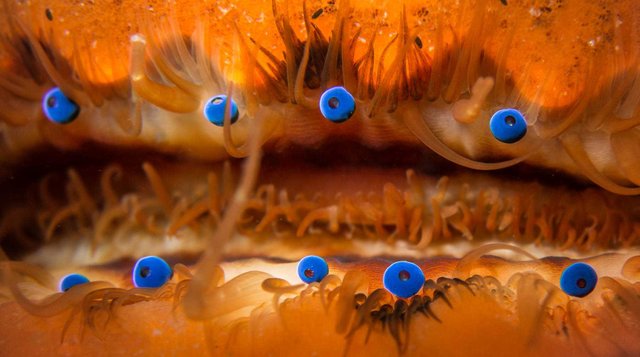
These bright blue beads are the eyes. image source
If you look closely, on the edge of the sink (on the soft mantle) you will be able to find a row of bright dots, resembling small pearls. These pearls represent the intricate eyes. Depending on the specific species, Pectinidae can have from 60 to 100 eyes!
Pectinidae is able to see everything that happens around, react to the approach of danger and navigate when swimming. Depending on the degree of threat, he can swim away, using the movement of valves of the shell to create a jet stream, or close the shell doors, creating a nearly impregnable fortress.
Surprising is not only the number of eyes, but also their origin. Unlike most other animals, scallop eyes are formed not by soft, but by mineral formations. Every single eye is a complete visual organ with a lens and retina, capable of detecting weak light and distinguishing moving objects.
But it remains a mystery how exactly the Pectinidae process the received visual information. The fact is that these animals don't have a visual center and they see the surrounding world differently than other animals with a complex brain and eyes.
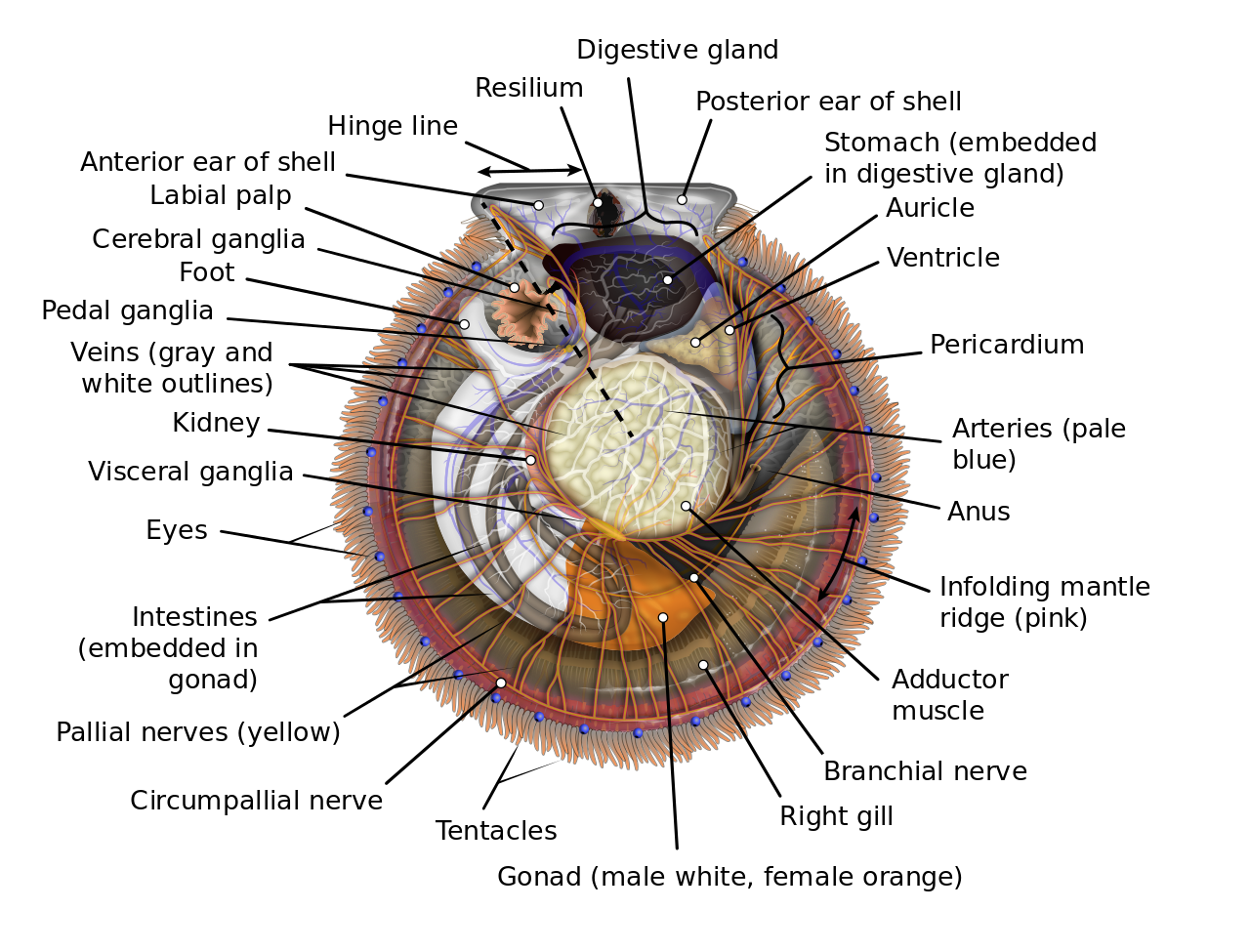
As you can see they have no CNS. image source
Scallops have the Autonomic nervous system, i.e. they have no main central hub of data processing, all data processed by separate neural nodes. Such a system is inherent in all simple mollusks, its task is to transmit incoming external signals as quickly as possible, increasing the speed of response of the animal to basic stimuli.
However, a number of studies have shown that Scallops can distinguish light areas from dark, see algae, recognize the movement and the obstacles on the way. How do they do it?
A detailed study of the Pectinidae's eye causes even more surprise and additional questions…
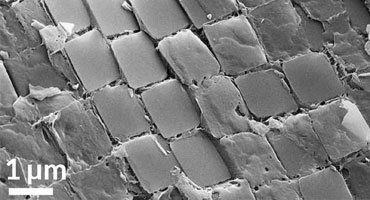
Micrograph of the reflecting crystals of guanine in the eye of a scallop image source
In itself the layer is transparent, but inside the eye of the mollusk there are 30 such layers. Due to this structure, and the location, this mirror may direct the light in different areas of the retina.
The reflection of light on the upper retina (located closer to the surface of the eye) provides the perception of dim light in the periphery of vision. The lower retina is responsible for the perception of movement in the center of the field of vision.
It's amazing, but people use this technology when creating mirrors for telescopes. For each of the lenses in a special form is laid transparent glass, which after heat treatment becomes solid and reflective surface. This is one of the future segments of the whole mirror.

Each segment is made separately. The error of the distance between the segments is reduced to nanometers image source.
This can not be seen with the naked eye, but the contour of each segment forms not a parabola, but something similar to the Pringles crisps.
This shape of the refractive surface makes it possible to capture and reflect waves of light in various ranges as efficiently as possible.
Hence, it can be concluded that the Pectinidae sees not just blurred objects in the immediate vicinity. His vision has a very high definition, and he is able to distinguish fine details (invisible to many other animals) at a great distance.
The Pectinidae has one more unexplainable ability, associated with his eyes. If the damage or loss of any of the 100 eyes, he can easily grow new, fully functional eye. This primitive animal can regenerate the organs of sight as many times as it wishes throughout its life.
Statistical data confirm an interesting theory: the simpler the organism is, the higher the probability of having a capacity for regeneration.
Regeneration compensates for the vulnerability of the animal due to a lack of other skills for survival. Imagine that you can choose only one improvement of the two:
- The developed mental and nervous system that effectively controls the actions of the body and allows to avoids serious damage to vital organs.
- Or regeneration - the ability to quickly restores lost organs and eliminates non-critical damage.
The limitations in obtaining only one of the two skills are associated with the high cost of resources for supporting each of these abilities. In the process of evolution, the body leaves only one of these skills, optimizing the costs of resources.
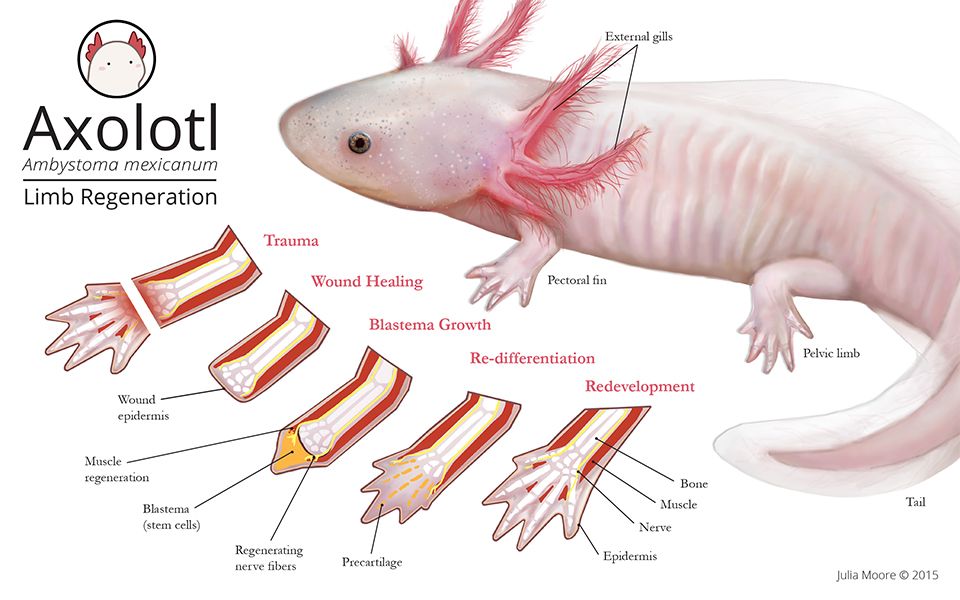
regeneration of limbs looks very simple, in comparison with regeneration of the eye. image source
Many simple animals are able to regenerate vital organs or body parts. But, the regeneration of such a complex organ as the Pectinidae’s eye must consume enormous resources of the organism. Because when forming a new eye, the scallop must to control and direct the growth of guanine crystals.
So, let's collect all of these amazing facts about the Pectinidae eyes together:
- 60-100 eye depending on the specific species. While most of the animals have only 2 eyes.
- Absence of a single visual center (brain). Information from any eye can be processed by any of the nerve nodes, located throughout the body.
- The each eye is a sophisticated organ, with retina, lens and the sensitive mirror. Exceeds the capabilities of the eyes of most of the higher animals.
- The ability to catch the slightest changes of light intensity. Wide viewing angle and vision in very high definition.
- Unlimited ability to regenerate eyes throughout life. Perhaps the efficiency of regeneration is related to the fact that the eye is formed with the help of mineral formations.
Thus, the eyes of the Pectinidae claims the title of the most complex and unusual visual organs in nature. The main question remains: for what purpose evolution had created such a complex mechanism for such simple animals?

The eyes of the sea scallop Placopecten magellanicus. (A) Eyes arrayed along the valve mantle margins of a live P. magellanicus. The scale bar represents 5 mm. (B) Cross-section of an eye from P. magellanicus. The sample was stained with Hoechst dye, staining cell nuclei blue, and alpha-tubulin, staining green. The pigment layer underneath the mirror appears red in the image and in vivo. (C) A labeled diagram corresponding to (B). The scale bar in (B) and (C) represents 100 μm. source
The eyes of representatives of each individual species have unique properties required for successful survival. The evolutionary process doesn't leave superfluous functionality in order to save the resources of the body. Each physiological ability should justify the resources spent on its use.
So for example, an organism living in the dark will never be endowed with good eyesight. It will receive only the minimum necessary for the perception of closest space, or even without eyes, or even lose sight as useless. Like these fish:
Phreatichthys andruzzii lost their eyes during evolution.
Evolution does not always mean improvement and development, it is primarily the search for a balance between acquiring and removing the abilities necessary for survival.
But, in the case of Scallops, such rules don’t work. They are primitive animals, who are not even hunters. They feed on microorganisms, filtering the water through the mantle. And they already have a good basic protection from predators in the form of a shell.
To date, science cannot answer the question of why Pectinidae are endowed with such complex eyes, and their organism spends a huge amount of resources on their creation and recovery.
***
Maybe, millions of years ago, these eyes were justified. After the disappearance of the threat that they were supposed to help avoid, evolution "decided" to leave the eyes of scallops unchanged. Maybe, replacement or elimination of such a complex system requires a large number of genetic changes and the cost of resources for the whole population. Well, we have to wait for further research of these outsiders of the evolutionary system.
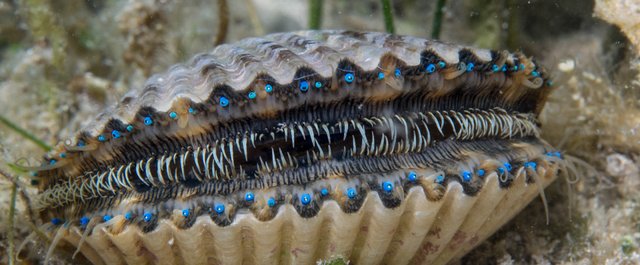
image source
P.S. What if they arrived from deep space for watching the most developed mammals on our planet... Dolphins !?
sources: De Novo Assembly and Characterization of Two Transcriptomes Reveal Multiple Light-Mediated Functions in the Scallop Eye, Scallop WiKi, Spectral sensitivity of the concave mirror eyes of scallops: potential influences of habitat, self-screening and longitudinal chromatic aberration, Modern synthesis, Naked science, The image-forming mirror in the eye of the scallop, Scallop and its amazing eyes, image from Google Search.


Incredible information, I imagine that this vision must be the best weapon of defense to avoid internal damage.
Well, it more like alarm system, however it will not help to avoid the threat from fast predators.